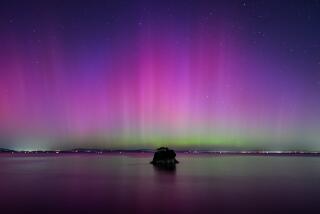Editorial: Just because we can light up the night sky like it’s noontime, doesn’t mean we should
The light appeared one day on the utility pole outside my house. I didn’t notice it until the sun went down and a harsh glare streamed through the living room window. I was perplexed. This was not a dark street. It already had a full complement of street lights, and the new owners of the gas station on the corner made the area even brighter by keeping their blue and white exterior lights on all night.
Someone probably asked for the additional street light in front of my house. It surely wasn’t me. If I had my way, I would take out one or two of the lights and require the gas station to cut the lamps at midnight. It feels like a losing battle. In the 15 years since I moved in, my Echo Park neighborhood has changed dramatically in a number of ways, including the lack of dark at night. I don’t know exactly how much brighter my little corner of Los Angeles is than in 2002, but I know that I now require blackout shades for a good night’s sleep.
Also, I know that I am not alone in experiencing brighter nights. Scientists using satellite data have calculated that night on Earth has become approximately 10% less dark in just the past five years. Part of this is because of humans’ continued encroachment into formerly wild and dark areas. Another reason is our collective enthusiasm for energy-saving light-emitting diodes. LEDs are cheaper to power, last for years and use blue light, which illuminates the landscape more effectively than the yellow sodium-vapor lights so common on American streets.
Light pollution is a lot easier to solve than climate change.
This trend is not new. Humans have been lighting up the night with an intensity that increased between 3% and 6% annually over the last half of the 20th century, German researchers found; now, half of Europe and a quarter of North America have lost a good deal of their night. There’s no evidence this trend is abating, as developing countries catch up with First World levels of outdoor lighting. And indeed LED technology may even accelerate the light pollution because it is cheaper to operate and lasts longer than other types of lighting. It’s a basic principle that if something is less expensive, we use of more it. (Gas below $3 a gallon? Road trip!)
This is a problem because, although there are solid public safety reasons for intelligently deployed exterior lights, there is a point at which too much light — particularly from LEDs — can be counterproductive. For example, high-intensity LEDs might make objects on the road clearer to pedestrians, but the glare can blind motorists and make the streets less safe.
That’s part of the reason that the American Medical Assn. recommended last year that city street lights use lower intensity LEDs, which are defined as having a color temperature of 3,000 Kelvin or less. (Los Angeles initially used 4,000 Kelvin LEDs when it began converting its 219,000 streetlights, but happily it has since switched to LEDs within the AMA’s safety zone.) The AMA also was worried about the health effects from too much night light. Humans, like many animals, are engineered to require darkness in order to get a good night’s sleep. Light at night reduces the production of melatonin, which regulates our sleep/wake cycle, interfering with our ability to get to sleep. That, in turn, makes us more vulnerable to sickness and even dementia. There’s also some research suggesting that light at night may be associated with cancer, diabetes and obesity. It’s not great for the health of many animals as well, but did you catch that part about how light pollution can make you fat?
Why aren’t people outraged about this? Probably because the light pollution has increased so gradually, we don’t really notice it. Also, there are plenty of other threats to worry about, such as climate change, nuclear war and Donald Trump. But guess what? Light pollution is a lot easier to solve than climate change. It’s just a matter of communities rethinking policies and individuals turning things off. In fact, hard as it is to believe, Los Angeles could qualify as dark-sky community by making a few changes to reduce glare, increasing public education and generally making smarter and more judicious use of outdoor light.
Just because we can afford to light up the world like noontime, it doesn’t mean we ought to. Besides, if we dial down the night lights and get a better sleep, maybe then we will all be rested enough to figure out how to stop climate change.
—Mariel Garza
Follow the Opinion section on Twitter @latimesopinion and Facebook
More to Read
A cure for the common opinion
Get thought-provoking perspectives with our weekly newsletter.
You may occasionally receive promotional content from the Los Angeles Times.










